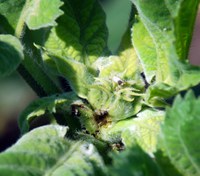Sunflower Bud Moth Damaging Sunflower Buds
(Click the image below to view a high-resolution image that can be downloaded)
Larvae of the sunflower bud moth, Suleima helianthana, have been observed damaging sunflower buds in R1 to R3 stage sunflowers, according to Janet Knodel, North Dakota State University Extension Service entomologist.
“Typically, most of the damage occurs in the stalk,” Knodel says. “However, this year sunflower bud moth emergence is delayed and larvae are feeding in the bud, which is causing injury to the developing head. The only time yield loss is noticeable is when larvae burrow into unopened buds, which prevents proper head development. The larvae normally do not feed on developing seeds, but confine feeding activities to the fleshy part of the head. The larva has a dark head capsule with a smooth, cream-colored body and is 0.31 to 0.43 inch (8 to 11 millimeters) at maturity.”
There are two generations of sunflower bud moths in North Dakota. Adults emerge from overwintering pupae during the last week of May to mid-June. A few days after adult emergence, eggs are deposited on the terminals of immature sunflowers or on the receptacle of mature sunflowers. Eggs also are deposited in leaf axils. The hatched larvae then begin tunneling into the sunflower plants. The initial infestation in mid-June is characterized by an entrance hole surrounded by black frass or insect excrement. Mature larvae pupate within the sunflower plants. Pupae move to the opening of the entrance holes formed in the stem or head tissue so that adults can emerge easily.
The second-generation adults appear in August. Infestation by the second-generation larvae is not economically important.
“A field monitoring scheme and economic threshold has not been established for sunflower bud moths because it has not been of economic significance most years,” Knodel says. “Insecticide use is not recommended for control of sunflower bud moths because the larvae are protected and feeding within the sunflower plants. As a result, insecticides will have limited efficacy and not come in contact with the larvae.”
NDSU Agriculture Communication
| Source: | Janet Knodel, (701) 231-7581, janet.knodel@ndsu.edu |
|---|---|
| Editor: | Rich Mattern, (701) 231-6136, richard.mattern@ndsu.edu |


